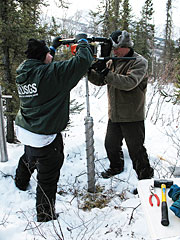- Number 351 |
- November 28, 2011
Assessing the organisms that could trigger abrupt climate change

Drilling for microbes in Alaskan
permafrost.
As temperature in the Arctic increases faster than in many other regions of the world, permafrost is poised to become a major source of greenhouse gases. Researchers from the United States Geological Survey (USGS), DOE’s Lawrence Berkeley National Laboratory (Berkeley Lab), and DOE’s Joint Genome Institute (JGI) have joined forces to identify the microbes and microbial communities that live in the permafrost and learn how they respond to a warming environment.
Janet Jansson of the Earth Sciences Division at DOE’s Lawrence Berkeley National Laboratory (Berkeley Lab) initiated the metagenomics study – a way of identifying the constituents of microbial communities from DNA studies of the entire ensemble, even though many of the individual organisms cannot survive in a laboratory environment and may be unknown. “By applying metagenomics to study microbial community composition and function, we can help to answer questions about how the currently uncultivated and unstudied microbial species residing in permafrost cycle organic carbon and release greenhouse gases during thaw,” she says.
The collaboration first started in 2010 with the Community Sequencing Program, a project led by Mark Waldrop of the USGS, who cored meter-deep permafrost samples from a peaty black spruce forest along Hess Creek, Alaska. After the cores were divided into “active” (seasonally melting and warming) and “permafrost” (permanently frozen) layers, the samples were sent to Jansson’s lab for DNA extraction and analysis. At JGI, Director Eddy Rubin and postdoc Rachel Mackelprang (now at California State University-Northridge) sequenced the DNA.
“These microbial communities are extremely diverse,” said Mackelprang. “A single gram of soil may contain thousands of different bacterial species and billions of cells.”
Due to the high microbial diversity of the soil, JGI generated nearly 40 billion bases of raw DNA sequence and identified several microbes that produced methane as a byproduct. Methane is a far more potent greenhouse gas than carbon dioxide. In the first successful assembly of a draft genome from a highly complex soil metagenome, they also identified a novel methanogen whose abundance suggests it may be an important player in methane production under frozen conditions. The study was also the first to describe a potentially nitrogen-fixing methanogen in permafrost soil. The findings were published online on November 6 in Nature.
At present, frozen Arctic soils keep an estimated 1.7 billion metric tons of carbon out of Earth’s atmosphere, more than 250 times the amount of greenhouse gas emissions attributed to the United States in the year 2009. As global temperatures slowly rise, however, so does the likelihood that this long-trapped carbon could be released with catastrophic effects.
Says Jansson, “Our study will provide valuable information that could lead to improved carbon cycle models and eventual mitigation strategies.”Submitted by DOE’s Lawrence Berkeley National Laboratory
